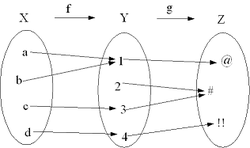Function composition
|
|
In mathematics, a composite function, formed by the composition of one function on another, represents the application of the former to the result of the application of the latter to the argument of the composite. The functions f: X → Y and g: Y → Z can be composed by first applying f to an argument x and then applying g to the result. Thus one obtains a function g o f: X → Z defined by (g o f)(x) = g(f(x)) for all x in X. The notation g o f is read as "g circle f" or "g composed with f".
As an example, suppose that an airplane's height at time t is given by the function h(t) and that the oxygen concentration at height x is given by the function c(x). Then (c o h)(t) describes the oxygen concentration around the plane at time t.
In the mid-20th century, some mathematicians decided that writing "g of" to mean "first apply f, then apply g" was too confusing and decided to change notations. They wrote "xf" for "f(x)" and "xfg" for "g(f(x))". However, this movement never caught on, and nowadays this notation is found only in old books.
The functions g and f commute with each other if g o f = f o g.
Derivatives of compositions involving differentiable functions can be found using the chain rule. "Higher" derivatives of such functions are given by Faà di Bruno's formula.
Functional powers
If Y⊂X then f may compose with itself; this is sometimes denoted f 2. Thus:
- (f o f)(x) = f(f(x)) = f 2(x)
- (f o f o f)(x) = f(f(f(x))) = f 3(x)
The functional powers f of n = f n o f = f n+1 for natural n follow immediately.
- By convention, f 0 = idD(f) (the identity map on the domain of f).
- If f admits an inverse function, negative functional powers f k (k < 0) are defined as the opposite power of the inverse function, (f−1)k.
Note: If f takes its values in a ring (in particular for real or complex-valued f), there is a risk of confusion, as fn could also stand for the n-fold product of f, e.g. f2(x) = f(x) · f(x).
(For usual numerical functions, usually the latter is meant, at least for positive exponents. For example, in trigonometry, this superscript notation represents standard exponentiation when used with trigonometric functions: sin2(x) = sin(x)·sin(x). However, for negative exponents (especially −1), it nevertheless usually refers to the inverse function, e.g., tan−1 = arctan (≠ 1/tan).
In some cases, an expression for f in g(x) = f r(x) can be derived from the rule for g given non-integer values of r. This is called fractional iteration.
Iterated functions occur naturally in the study of fractals and dynamical systems.

